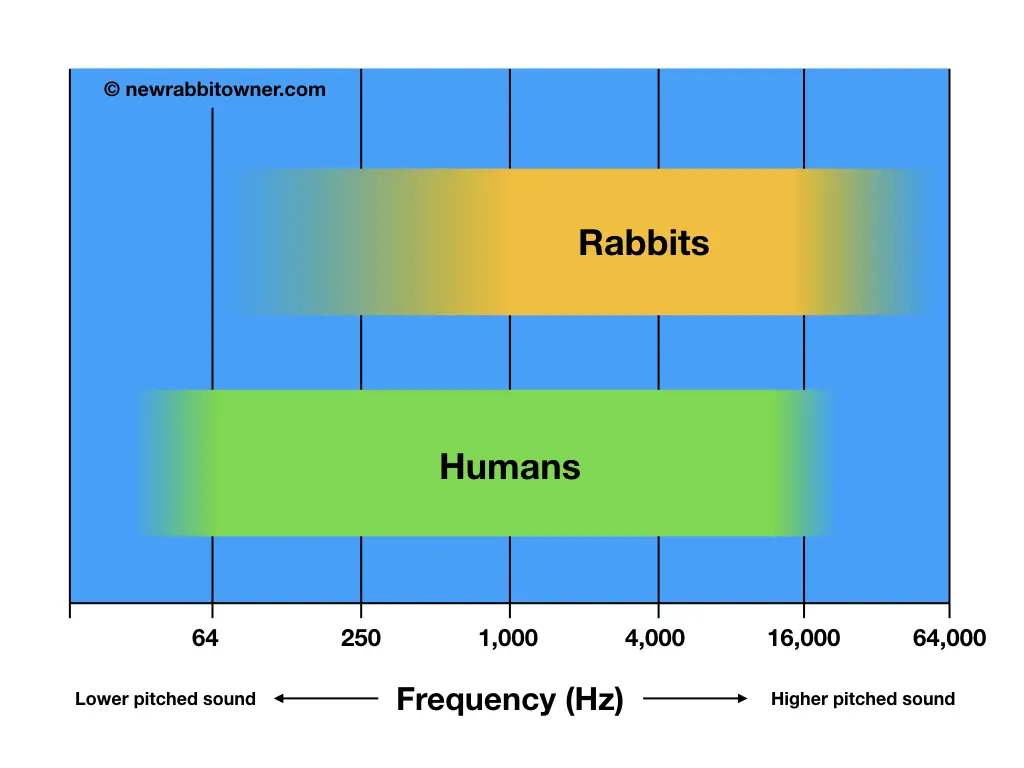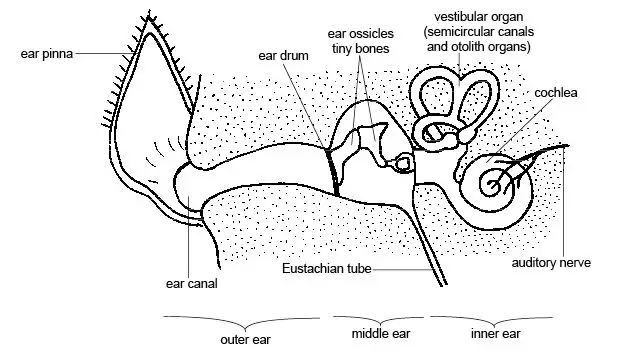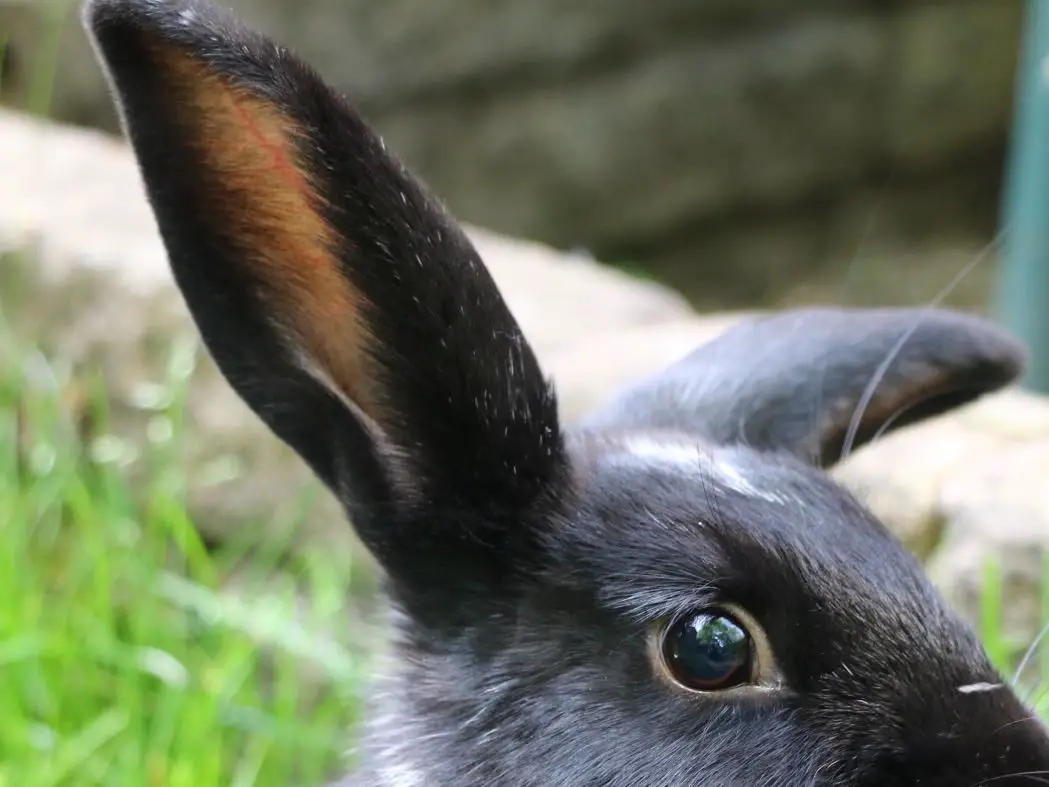Everyone knows that rabbits have distinctive ears (what shape are your bunny’s ears?) – but how well do bunnies hear? You can find out below detailed answers to your questions, based on scientific research. But here’s a quick summary of how rabbits hear:
Do rabbits have good hearing?
Rabbits have good hearing for high pitched sounds, but humans are better with deep, low sounds. Rabbits can hear in a range from 96Hz to 49,000Hz (humans can hear lower-pitched noises, but rabbits can hear much higher-pitched noises). They hear noises best whose pitch is between 1,000-16,000Hz. But rabbits don’t only use their ears for hearing – they also use them to communicate, to help them stay the right temperature, and to keep their balance.
This post covers:
- The range of noises rabbits can hear
- How well rabbits detect low-pitched noises
- How well rabbits detect high-pitched noises
- The noises that rabbits hear best
- How rabbits’ ears help them to hear
- The structure of a rabbit’s ear
- How rabbits’ ears move independently
- How rabbits use their ears to communicate, to cool down and to balance
The range of frequencies that a rabbit can hear – from low to high notes
Rabbits can hear a different range of frequencies from us humans (though with much overlap).
The frequency of a sound is its pitch – low frequency sounds are low-pitched noises like the bass on a guitar, or the lowest note on a piano, or the rumbling of thunder. High frequency sounds are high-pitched noises like a whistle, or the top note of a piano, or a mosquito buzzing around.
Rabbits can hear very high pitched sounds better than humans (they can hear sounds that are beyond our ability to detect).
But humans can hear very low notes better than rabbits.

The range that rabbits can hear is 96Hz to 49,000Hz [source].
Humans can hear from 12Hz to 20,000Hz.
How well can rabbits detect low pitched sounds?
The pitch of a sound (whether it sounds high or low) depends on its frequency (measured in Hertz or Hz) – how fast it is making the air vibrate as the sound travels. Low sounds have low frequency – high sounds have high frequency.
Rabbits can hear sounds as low as 96 Hz. [Source]
You can check here what this sounds like:
This is better than most other mammals, but it isn’t exceptional. For example, it’s about the same as cats.
But humans can detect even lower sounds – in laboratory conditions down to 12 Hz. [Source]
This may be partly to do with us having bigger heads! As the frequency of a sound wave gets lower, the wavelength gets longer.
It becomes an advantage to be able to have more distance between your ears as the pitch gets lower and the wavelength gets longer.
Humans have more distance between their ears than rabbits, so find it easier to hear low pitched noises.
This is part of a pattern in mammals – the smaller the mammal, in general the worse their hearing at low frequencies.
How well can rabbits hear high-pitched sounds?
Rabbits can hear sounds as high as 49,000 Hz.
This is much better than us. Most humans struggle to hear anything above about 20,000 Hz.
You can check out how high a frequency you can detect here (and compare yourself to your bunny!)
So our bunnies can hear high-pitched noises that we can’t detect.
What is the best range of sound for rabbits to hear?
Although rabbits can hear noises as low as 96hz, and as high as 49,000Hz, they hear best between the range of 1,000 to 16,000Hz. These are the frequency ranges that they are most sensitive to.
How do their ears help rabbits hear?
Rabbits have large ears – this helps them to hear better. The ears funnel sound waves into their ear canals, and into the middle and inner parts of the ear, which transform these vibrations into signals to the rabbit’s brain.
This is just like humans – except our ears are shaped differently.
You can get some idea of the advantage of a bigger ear by standing some distance from a friend and asking them to whisper. It’s easier to hear them if you cup your hand behind your ear. This mimics having a larger ear.
It’s a bit like if you imagine trying to collect rainwater – you’ll collect more with a wide bucket than a narrow bottle. In the same way, larger ears can collect more sound waves.
What is the structure of a rabbit’s ear?
Rabbits have three main parts to their ears – the outer ear (the bit we can see); a middle ear (inside their head) and an inner ear (also inside their head). This is similar to humans.

Sunshineconnelly at en.wikibooks / CC BY (https://creativecommons.org/licenses/by/3.0)
Outer ear
The outer ear is called the pinna, and it directs the sound into the ear canal. This starts off vertical, and becomes more horizontal as it gets closer to the skull.
The ear canal leads to the ear drum (also called the tympanum or tympanic membrane).
Sound waves make the ear drum vibrate.
Middle ear
Three small bones are attached to the ear drum. These small bones (also called ossicles) are called the malleus, incus and stapes, which is the Latin for the hammer, anvil and stirrup (because the bones look a little like these).
The vibrations in the ear drum are passed from one to another – from the malleus to the incus to the stapes.
The middle ear is filled with air. If a sound wave hit a fluid directly, much of the energy might be dissipated. Having these three small bones in an air cavity means that the energy of the sound isn’t lost as it’s transferred.
You want to be able to keep the air pressure the same on both sides of the ear drum. Rabbits and humans both have a tube that connects to the throat – the eustachian tube. It allows air to come or go to the middle ear cavity to keep the pressure the same.
This is why going up to a high altitude quickly (or down) can hurt our ears – the air pressure on either side of the ear drum is different, stretching the ear drum. Swallowing can help as it enables air to flow in the tube to the middle ear, bringing everything back into equilibrium.
Inner ear
The stapes or stirrup bone connects to the cochlea, a fluid filled spiral tube. The cochlea has a membrane running along it (the basilar membrane) that gradually changes in its stiffness and thickness as you travel along it. This means that each part of the basilar membrane reacts to a different frequency (just like different lengths of string will vibrate at different pitches).
The vibrations enter the cochlea and travel along it. Certain parts of the basilar membrane will vibrate if they match the frequency of the vibrations (low frequencies near the middle or apex of the spiral, higher frequencies towards the outside of the spiral).
Little hairs (called cilia) on the basilar membrane move and trigger nerve cells, sending electrical signals along the auditory nerve to the brain.
The whole process is the same as in humans (and most mammals).
Rabbits can move their ears independently
Rabbits can move their ears, unlike humans (though some of us can waggle ours a tiny bit). But not only can they move their ears, bunnies can also move each one independently of the other.
This helps them to hear better (just like if you turn towards a noise you can hear it better).
So if the rabbit either hears a noise, or sees something (you can read more about how rabbits see, including how they can see all around them, in our post here), they can move an ear so it can pick up what’s going on better.
In the wild, this helps them to hear any predators who may be trying to sneak up on them.
What else do bunnies use their ears for, besides hearing?
Rabbits don’t only use their ears to hear the world better. They also use them for three other purposes: to communicate, to control their temperature, and as part of their sense of balance.
Rabbits communicate with their ears

Bunnies also use their ears to communicate – and if your rabbit isn’t a lop, you’ve probably seen this yourself. Even with lops, you can still see similar movements of the ears near the head.
If a rabbit is frightened, the ears go back, almost flat along their back. Their body will also tense up.
However, the ears can also go back if your bunny is relaxed.
If a rabbit is curious or interested, the ears prick up and forward.
Rabbits control their temperature with their ears
Rabbits don’t sweat. Their only sweat glands are in their mouth, and bunnies mainly breathe through their noses, so the sweat glands aren’t much help.
Unlike dogs, rabbits don’t pant much either (though they will in hotter weather, along with licking their face and forelimbs to try to keep cooler).
With their thick, warm fur coat (see our article on whether rabbits feel the cold at night), rabbits need a way of cooling down (getting too hot, also called hyperthermia, is dangerous for rabbits).
Rabbits use their ears for this. The ears provide a large surface area that also isn’t too furry.
The ears have a large blood supply going to them.
In hot weather, more blood is pumped around the ears, where it can be cooled down in contact with the air around them. In cooler weather, less blood is sent to the ears.
So the ears provide a main way that rabbits can lose heat and maintain the right temperature in hot conditions.
In fact, rabbits can lose up to 50% of their heat just through their ears [source]!
Rabbits aren’t the only mammals that use large ears for air conditioning – this is also why elephants have such large ears.
Rabbits’ sense of balance is linked to their ears
How rabbits balance is also part of their ears – but not the part you can see. Of the three parts (outer, middle and inner), the inner ear controls balance.
Alongside the cochlear, the spiral tube that converts vibrations to electrical signals for the brain, lie three semi-circular canals at right angles to each other – these are part of what is sometimes called the vestibular organ.
These canals help detect rotational movements. As your bunny moves their head, fluid in the canals swoshes around. This move hairs in the canals, which then send electrical signals via nerve cells to the brain.
Rabbits (like humans) also have otoliths. These help them detect how fast or slow they are going. Little bits of calcium carbonate move in fluid in the vestibule. As they move, they trigger more hair cells, which then trigger signals through nerves to the brain.
The entire inner ear structure – cochlea, vestibule and semi-circular canals – are sometimes called the labyrinth.
Head tilt
If the inner ear of a rabbit gets infected, then it can affect their balance. The signals being sent from the semi-circular canals or otoliths are being scrambled.
The result can be that a rabbit keeps trying to tilt their head to one side.
Inner ear infection is only one possible cause of head tilt.
If your rabbit shows signs of head tilt, take them straight to a vet.
Conclusion
Rabbits are famous for their ears – and rightly so.
- Their ears help them to hear, including high pitched noises beyond human hearing.
- Their ears help them to communicate.
- Their ears help them to control how hot or cold they’re getting.
- And their ears help them to balance.
So next time you stroke your bunny, take a moment to appreciate how much they use their ears.
You can find out how rabbits see the world from our article here. (We also have an article on bunny eye care.)
We also have an article on how and when rabbits sleep.
Rabbits are amazing. Discover some fantastic facts about their teeth.
And there’s more! Ever wondered how fast your bunny can run, or how high they can hop?
And if you want some suggestions for some toys to keep your bunny happy and busy, take a look at our top ten.
References
Heffner, H., & Masterton, B. (1980). Hearing in Glires: Domestic rabbit, cotton rat, feral house mouse, and kangaroo rat. The Journal of the Acoustical Society of America, 68(6), 1584-1599. doi:10.1121/1.385213
Kluger, M., Gonzalez, R., & Stolwijk, J. (1973). Temperature regulation in the exercising rabbit. American Journal of Physiology-Legacy Content, 224(1), 130-135. doi:10.1152/ajplegacy.1973.224.1.130


